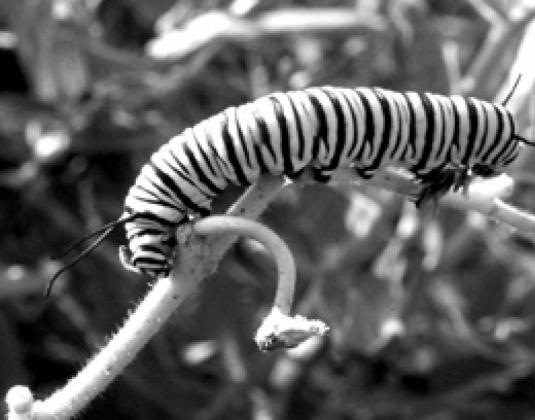Migrating monarch butterflies are dumping on Oklahoma these days. They’re not being critical, just doing something a little worrisome.
This happens to some degree every year but some years are worse than others. Lingering cold and late green-up this season could make springtime 2022 a rough one for early migrants of the threatened butterfly species now moving north from overwintering grounds in Mexico.
“Egg dumping occurs when there is too little milkweed relative to the situation,” said Chip Taylor, founder and director of Monarch Watch at the University of Kansas.
Varieties of milkweed are the only suitable food sources for monarch caterpillars. Ideally, a female will find enough plants to lay one egg per milkweed, across a wide area, for her 100 to 300 eggs. That’s the ideal survival strategy, Taylor said.
Overall, the spring migration for monarchs is off to a bit of a shaky start with a combination of cold weather hanging on later and some early migrants already pushing up through Oklahoma and Kansas, where milkweed is still in short supply, he said.
International travelers
This first generation of monarchs is the group that flew south from Oklahoma and Texas last fall and overwintered in Mexico. In the springtime, they fly north and lay eggs mostly in the southern states. The next generation hatches to continue the journey to northern states and southern Canada.
Sandra Schwinn, Monarch Watch conservation specialist for Oklahoma, said Facebook pages dedicated to the butterflies are loading up with some photos from people seeing piles of eggs on tiny sprigs of milkweed just now popping up out of the ground.
“No one seems too worried about it right now. The caterpillars are still small,” she said. “In a week or so some people might be feeling the crunch.”
Taylor and Schwinn said that, while the egg-dumping situation isn’t always good, nature does have some ways to cope and that people shouldn’t worry too much.
Taylor related a story to explain how dumping happens.
He said he was talking with a friend and noticed a tattered monarch with a chip out of one wing laying an egg on a small sprig of milkweed nearby.
“She flew away and about 10 minutes later she was back and laying another egg, and then she was gone, and back again, then again, and again. She was flying away and looking for more milkweed and then coming back when she didn’t find any,” he said. “She laid 7 eggs in a row on one plant, but they don’t just lay them all at one time, they will look for other plants in the area first.”
Natural uncertainty
Two things make egg dumping a bad thing, Taylor said. Caterpillars will starve if they hatch before the plant has time to grow. They might starve while searching for other milkweeds, too, he said.
Predators like ants and wasps the other issue.
“If a predator comes along it will eat them all,” he said. “If you’re an ant, finding all those eggs in one place, that’s a big deal!”
Much depends on the weather, the experts said.
“Some native milkweed plants come up pretty fast and provide quite a bit of food,” Schwinn said. “I have seen plants emerge and flower in a two-week period with good temperatures.”
Likewise, the caterpillar eggs might wait for good weather—if predators don’t get to them first—Taylor said.
“I once had a situation in Kansas with monarchs that came April 6th or 7th and there was a lot of egg dumping. The weather was cool and I was able to follow some eggs up to 19 days before they hatched,” he said. “Normally they will hatch in 4 or 5 days.”
Schwinn said shaky starts are not unusual for the insects, it’s just that as they are fewer in number these days so it becomes a bit more worrisome.
“Should we be concerned this year? I don’t know. Time will tell,” she said. “What happens in the summer breeding areas will be as important or more important than what is happening here. Every year brings with it uncertainty.”

